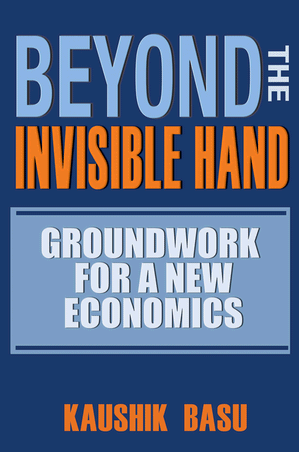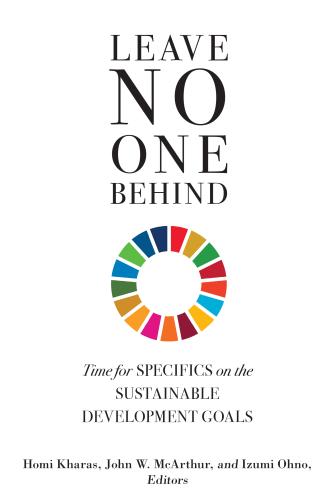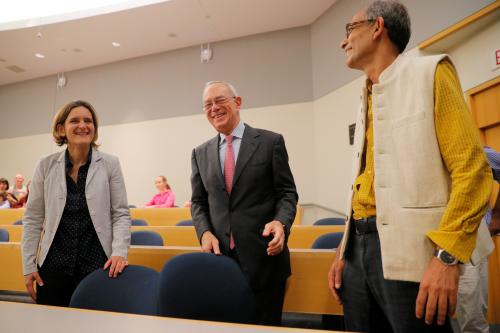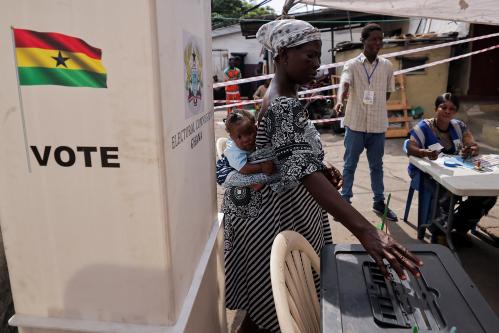The 2019 Nobel Memorial Prize in Economics Sciences was awarded to Abhijit Banerjee, Esther Duflo, and Michael Kremer “for their experimental approach to alleviating global poverty.” Their experimental work has changed the culture of economics, especially development economics. It helped change deep assumptions about how individuals make decisions and about what economic development is. It changed the way many development economists work, where they work, and the kinds of people they work with.
The rational actor is just one of many ways to model the economic agent
In the last 30 years, a new field in economics—behavioral economics—emerged. A premise of behavioral economics is that the most useful model of the individual to explain aggregate economic behavior is often not the rational actor model. Initially, there were no applications of behavioral economics in developing countries. Without any priors about the best way to model the decisionmaker, Banerjee, Duflo, and Kremer made discoveries that filled this gap. To explain too little purchase of fertilizer by Kenyan farmers, too little treatment with dilute chlorine of often contaminated drinking water in Kenya, too little immunization of children against life-threatening diseases in villages in India where immunization is free and on special days made very accessible, and the rapid spread of HIV among young people in Nigeria, the three researchers’ experiments demonstrated the value of applying central ideas from behavioral economics—present bias, impatience, salience, framing effects, and the ability of narratives to transmit information in ways that overcome resistance to top-down advice. Their work made possible large advances in real-world policies to offset individuals’ biases in ways that made their lives much better.
The contribution that the experimental approach can make to economics was generally misunderstood until the work of Banerjee, Duflo, and Kremer. In the mid-1990s, Ernst Fehr (a leader in inventing experimental games) gave a seminar in a conference in Italy at which Banerjee, Kremer, and Jean-Jacques Laffont were present. After Fehr’s presentation, Laffont asked the question, “Why should economists run experiments?” Implicitly, I think his question was a directive: You should focus your work on deductions from theory. Today no one would question that randomized controlled trials (RCTs) are a central part of a cumulative knowledge program in economics. They can be oversold and undersold, but a review by two of the harshest critics of RCTs, the Nobel laureate Angus Deaton and the philosopher Nancy Cartwright, concludes that they play a critical role in advancing economic knowledge.
Where development economists work
Banerjee, Duflo, and Kremer have changed the working lives of many development economists. In the past, their visits to the field stimulated important new ideas, but most development economists did their work at a desk, drawing out deductions. Now many more development economists do experimental work, with lots of time working in the field.
Big teams
Field experiments require teams of facilitators of many kinds. Economists used to work largely on their own, but many development economists now work with tens or hundreds of people and with non-government organizations, governments, and private firms. Banerjee, Duflo, and Kremer have created the infrastructure to help people do that.
Changing people, not just incentives
The most important and, I think, under-appreciated change to which their work has contributed is a change in what development economics is about. Traditional development economics is about increasing GDP per capita through improvements in markets, technology, and public goods. Development economists (like all neoclassical economists) believed that changing the rules of the game was important only because it would get the same old people to behave in more socially beneficial ways. But Kremer, Banerjee, and Duflo have shown that changing the rules can shape new people who are critical to bringing about expansions in capabilities. This can be especially important for the ultra poor, since the stress of poverty changes cognition and preferences. Banerjee, Duflo, and colleagues showed that a multi-faceted 18-24-month program developed in Bangladesh for the ultra poor was successful because it changed the way people think and therefore behave. The program included a transfer of the recipient’s choice of a valuable asset (e.g., in India, most participants chose a cow), short-term consumption support, and two years of weekly visits for “hand-holding” to encourage motivation. The impact persisted and indeed grew after 7 years in the two countries with evaluations 7 years after beneficiaries no longer were supported. They write, “The trajectories of the beneficiaries continue to diverge from the control group.” Stripping out the non-resource elements of the program made the program ineffective.
One way to measure cognitive effects is through self-portraits that children draw. Psychologists have shown that choosing dark over light colors is consistently correlated with depression and anxiety, and a tiny figure is correlated with low self-esteem. Standing under an umbrella is correlated with self-efficacy. A direct aid program from rich countries to children in poor countries (Compassion International) has had substantial impacts on both objective outcomes (years of schooling, employment in white-collar jobs, earnings) and aspirations.
Bruce Wydick and colleagues asked children in Jakarta to “Draw a picture of yourself in the rain.” The researchers chose 20 characteristics from the empirical literature to focus on before the study began. Drawings were coded blindly without knowledge of the treatment status. For the presence in a self-portrait of each of the 20 positive characteristics (such as light colors and standing under an umbrella), it received an additional point. Here are two examples of the pictures the children drew:

With this method, Wydick and colleagues estimated that international sponsorship raised sponsored children’s self-efficacy by more than one-fourth of a standard deviation and their hope by two-thirds of a standard deviation.
Changing norms and cultural categories
I’ll mention just one more example of the Nobel laureates’ work: an evaluation of a constitutional amendment in India that reserved for women the position of village chief (pradhan) in a randomly chosen one-third of all villages. The evaluation in the state of West Bengal shows that associated with 7 years of a female village head were increases in parents’ aspirations for their teenage daughters and in the daughters’ aspirations for themselves. Yet there was no change in objective opportunities—no change in young adult educational outcomes, young adult labor market outcomes, or public support to the poor. What changed was the meaning of gender categories: “village leader” no longer meant “man.” The psychological change probably played a role in the reduction in bias against women as political leaders in West Bengal, which Duflo and coauthors had earlier demonstrated in several ways. In particular, in free elections that followed a period of political reservations for women in a village, more women ran and more women won elections as village head. Duflo and colleagues reported that many fathers said of a daughter, “I want her to grow up to be a pradhan (a village chief).”
Inequality of power between groups creates not only unequal opportunities between the groups, but also a common belief that the groups differ innately. The belief leads to behaviors that perpetuate the inequalities long after formal barriers that excluded the disadvantaged groups have been repealed. In my own work, I’ve emphasized that an important function of law and policy is to transform cultural categories that perpetuate social exclusion. Such law and policy are needed to change “equilibrium fictions”—false stereotypes that create objective realities that sustain false beliefs. Duflo and her colleagues’ work in West Bengal on political reservations for women shows what a change in the meaning of a cultural category can accomplish.
Banerjee, Duflo, and Kremer took large risks. They demonstrate the power of the experimental approach to reveal what does work. Twenty years ago, perhaps only they could imagine how fruitful this approach would be.
The Brookings Institution is committed to quality, independence, and impact.
We are supported by a diverse array of funders. In line with our values and policies, each Brookings publication represents the sole views of its author(s).










Commentary
Changing the culture of economics: The 2019 Nobel laureates
November 7, 2019